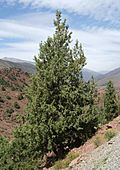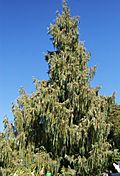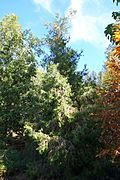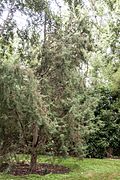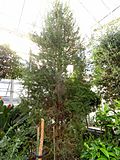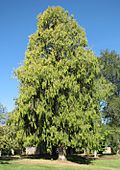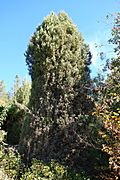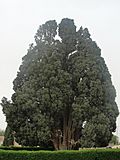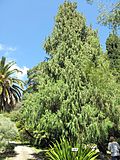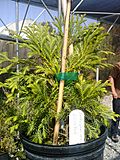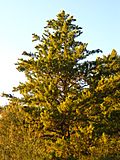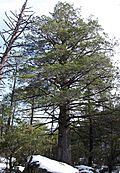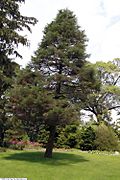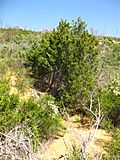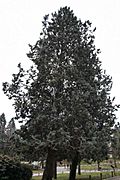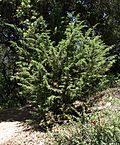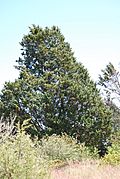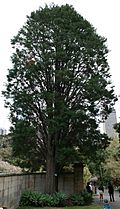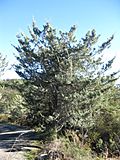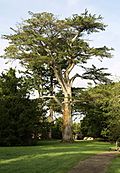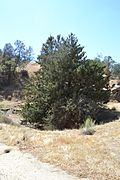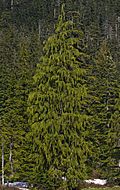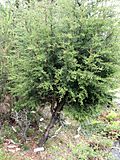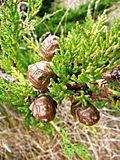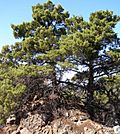Cupressus facts for kids
Quick facts for kids Cupressus |
|
|---|---|
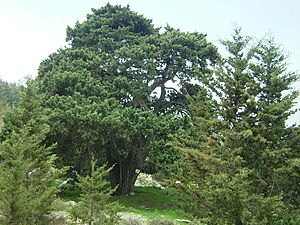 |
|
| Cupressus sempervirens | |
| Scientific classification |
|
| Kingdom: | Plantae |
| Clade: | Tracheophytes |
| Division: | Pinophyta |
| Class: | Pinopsida |
| Order: | Pinales |
| Family: | Cupressaceae |
| Subfamily: | Cupressoideae |
| Genus: | Cupressus L. |
| Species | |
|
See text |
|
Cupressus is a group of evergreen trees and large shrubs, commonly known as cypress trees. These trees are part of the Cupressaceae family. The name "cypress" comes from an old French word, which came from the Latin word cyparissus, meaning the same thing.
Contents
About Cypress Trees
Cypress trees are evergreen, meaning they keep their leaves all year round. They can grow quite tall, from 5 to 40 meters (about 16 to 130 feet). Their leaves are small and flat, like scales, usually 2–6 mm long. These leaves stay on the tree for three to five years. When the plants are very young, their leaves are more like needles, about 5–15 mm long.
Cypress trees produce cones. These cones are 8–40 mm long and can be round or egg-shaped. They have four to 14 scales. It takes about 18 to 24 months for the cones to fully grow after pollination. Inside the cones are small seeds, about 4–7 mm long, with two thin wings on each side. These wings help the seeds fly away in the wind.
Many cypress species are good at surviving forest fires. They keep their seeds safe inside closed cones for many years. When a fire happens and the parent tree dies, the heat makes the cones open. This releases the seeds onto the burnt ground, allowing new trees to grow. Other types of cypress trees simply open their cones when the seeds are ready.
Where Do Cypress Trees Grow?
Cypress trees naturally grow in different places around the Northern Hemisphere. You can find them in warm areas like western North America, Central America, northwest Africa, the Middle East, the Himalayas, southern China, and northern Vietnam.
Because people like how they look, cypress trees are now grown in parks and gardens all over the world. This means it can sometimes be hard to tell where a cypress tree originally came from!
How Are Cypress Trees Used?
Many types of cypress trees are planted as beautiful, decorative trees in parks and around temples, especially in Asia. Some species are also grown for their wood, which is very strong and lasts a long time.
A popular tree for gardens is the Leyland cypress (Cupressus × leylandii). This tree is a hybrid, meaning it's a mix of two different parent trees. One parent is the Monterey cypress (Cupressus macrocarpa), which is a type of Cupressus.
Types of Cypress Trees
Scientists don't always agree on the exact number of cypress species. Some say there are 16, while others count 25 or more! This is because many cypress groups are small and grow in isolated places. It can be tricky to decide if they are a completely new species or just a different kind of an existing one.
Cypress Trees from the Old World
"Old World" cypress trees are found in places like Europe, Asia, and Africa. They usually have cones with more scales (8–14 scales). Each scale has a short, wide ridge. The C. sempervirens (Mediterranean cypress) is a very well-known type of cypress from the Old World.
| Image | Cone | Name | Common Name | Where it grows |
|---|---|---|---|---|
| Cupressus atlantica | Moroccan cypress | western Morocco. | ||
| Cupressus cashmeriana | Bhutan cypress | eastern Himalaya in Bhutan and parts of India. | ||
| Cupressus chengiana | Cheng's cypress | Gansu and Sichuan Provinces, China. | ||
| Cupressus duclouxiana | Yunnan cypress, South Tibet cypress | Yunnan and Sichuan, China. | ||
| Cupressus dupreziana | Saharan cypress | southeast Algeria. | ||
| Cupressus funebris | Chinese weeping cypress | southwestern and central China. | ||
| Cupressus gigantea | Tibetan cypress | Southeast Tibet - China. | ||
| Cupressus sempervirens | Mediterranean cypress | northeast Libya, southern Albania, coastal Bulgaria, southern coastal Croatia, southern Montenegro, southern Bosnia and Herzegovina, southern Greece, southern Turkey, Cyprus, northern Egypt, western Syria, Lebanon, Malta, Italy, Israel, western Jordan, and Iran. | ||
| Cupressus torulosa | Tonkin cypress, Himalayan cypress | Sichuan of China and in Vietnam. | ||
| Cupressus vietnamensis | Vietnamese cypress, Vietnamese golden cypress | Vietnam. |
Cypress Trees from the New World
"New World" cypress trees are found in North and Central America. These types usually have cones with fewer scales (4-8 scales). Each scale often has a clear, narrow spike. Recent studies show that these New World cypresses are not as closely related to the Old World ones as once thought. They are now sometimes placed in a different group called Callitropsis.
These New World species often grow in dry, desert-like areas. They tend to be found in small, separate groups.
| Image | Cone | Name | Common Name | Where it grows |
|---|---|---|---|---|
| Cupressus abramsiana | Santa Cruz cypress | Santa Cruz Mountains of Santa Cruz and San Mateo Counties in west-central California. | ||
| Cupressus arizonica | Arizona cypress | southwestern United States (Arizona, Utah, southwestern New Mexico, and southern California, with a few populations in southern Nevada and in the Chisos Mountains of western Texas), and in Mexico (Coahuila, Nuevo León, Chihuahua, Sonora, Durango, Tamaulipas, Zacatecas and northern Baja California). | ||
| Cupressus bakeri | Modoc cypress | northern California and extreme southwestern Oregon. | ||
| Cupressus forbesii | Tecate cypress | Santa Ana Mountains of Orange County and in San Diego County within Southern California, and in northern Baja California state of Mexico. | ||
| Cupressus glabra | smooth Arizona cypress | Sedona, Arizona. | ||
| Cupressus goveniana | Gowen cypress, Californian cypress | Monterey County, California. | ||
| Cupressus guadalupensis | Guadalupe cypress | Mexico, found only on Guadalupe Island. | ||
| Cupressus lusitanica | Mexican cypress | Mexico and Central America (Guatemala, El Salvador and Honduras). | ||
| Cupressus macnabiana | Macnab cypress | northern California. | ||
| Cupressus macrocarpa | Monterey cypress | Cypress Point in Pebble Beach and at Point Lobos near Carmel, California. | ||
| Cupressus montana | San Pedro Martir cypress | Mexico: Baja California. | ||
| Cupressus nevadensis | Piute cypress | Southern Sierra Nevada, within Kern County, California and Tulare County. | ||
| Cupressus nootkatensis | Nootka cypress | Vancouver Island, British Columbia, Canada. | ||
| Cupressus pigmaea | Mendocino cypress | Mendocino and Sonoma Counties in northwestern California. | ||
| Cupressus revealiana | El Rincon cypress | Baja California in northwestern Mexico. | ||
| Cupressus sargentii | Sargent cypress | Mendocino County southwards to Santa Barbara County California. | ||
| Cupressus stephensonii | Cuyamaca cypress | San Diego County California. |
Cypress Pollen and Allergies
All cypress plants, including those from the New World, can cause strong allergies. They have a very high allergy rating. In warm, Mediterranean places, these plants release a lot of pollen for about seven months each year. This pollen can cause allergy symptoms in many people.
|
See also
 In Spanish: Ciprés para niños
In Spanish: Ciprés para niños


